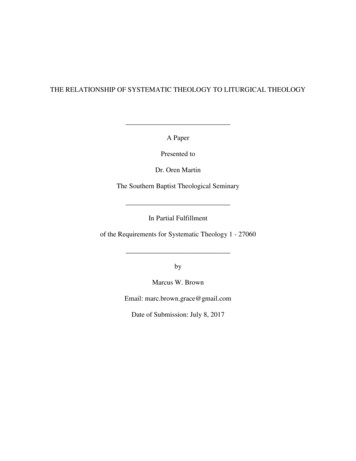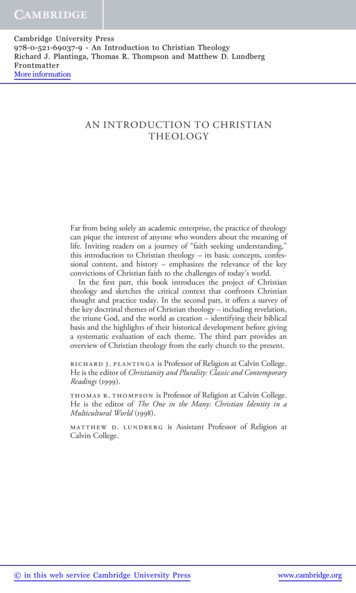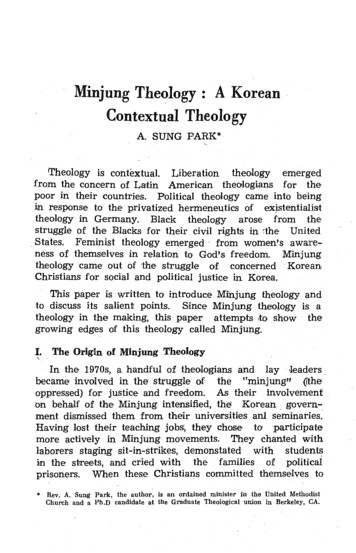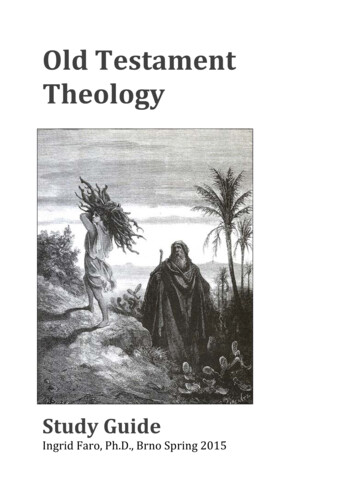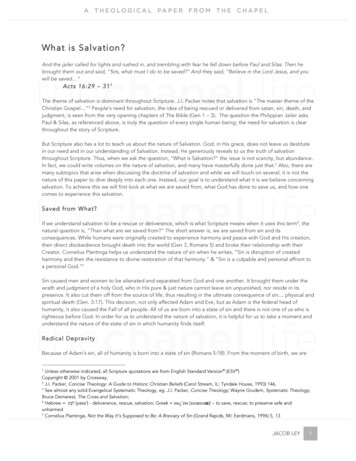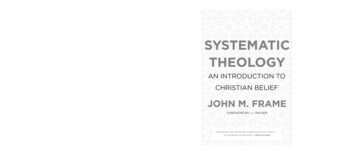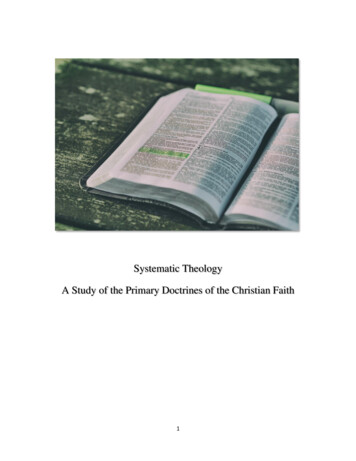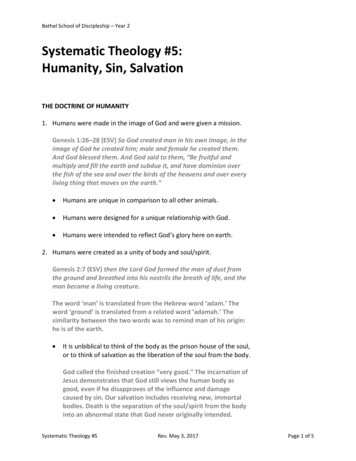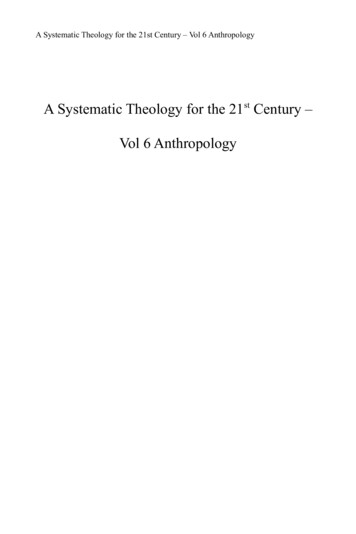
Transcription
A Systematic Theology for the 21st Century – Vol 6 AnthropologyA Systematic Theology for the 21st Century –Vol 6 Anthropology
A Systematic Theology for the 21st Century –Vol 6 AnthropologyDr. Edward Rice
Copyright: Creative Commons Attribution 2.0"Share — copy and redistribute the material in any medium or format, and Adapt —remix, transform, and build upon the material for any purpose, even commercially."Published byGood Samaritan Baptist Church GSBaptistChurch.com54 Main St. Box 99, Dresden, NY hCover Design and Photographs by:Edward G. RiceScripture Quotations are from the non-copyrightKing James Authorized Version
A Systematic Theology for the 21st Century –Vol 6 t vol06Anthropology.pdfTable of ContentsA Systematic Theology for the 21st Century – Vol 6 Anthropology.1Chapter 1 – Introduction. 1Chapter 2 – Cambron's Chap IV Anthropology -The Doctrine of Man 4I. Man In His State of Integrity.5II. Man In His State of Sin. 14III. Man In His State of Grace.19Chapter 3 – A Six Day Creation .25Six Days With No Evolution.28Six Days With No Gap.31Six Days, No Gap, No Half-breed Angels But a DepravedHumanity.39Chapter 4 – The Depravity of Man.42Chapter 5 – The Seven Dispensations for Mankind. 50The First Dispensation – Innocence.58The Second Dispensation – Conscience . 59The Third Dispensation – Government .60The Fourth Dispensation – Promise .61The Fifth Dispensation – Law.62The Sixth Dispensation – Grace and Truth. 64The Seventh Dispensation – The Kingdom.66Chapter 6 – Critique of Other Systematic Theology – Anthropologies.69Critique of Augustus Strong's Anthropology. 69Critique of Chafer's Anthropology.72Critique of Chafers Material/Immaterial Part of Man .78Critique of Chafer's State of Innocence and Fall. 78A Critique of Augustus H. Strong's 1907 Systematic Theology –Anthropology. 80A Critique of Charles Hodge's 1871 Systematic Theology –v21cent vol06Anthropology.odt 10/07/21
Anthropology. 83A Critique of Norman L. Geisler's 2002 Systematic Theology –Anthropology. 83Chapter 7 – Anthropology Conclusion . 84Bibliography for Anthropology.86vi21cent vol06Anthropology.odt 10/07/21
PrefaceGreetings in the name ofthe Lord Jesus Christ.As a USAF retiredsystems engineer turnedBaptist Preacher of theGospel of our Lord JesusChrist, and armed with astaunch belief in thepreserved accuracy of theinspired Scriptures, Ipraise the Lord that hehas provided me the unique opportunity to assemble “A SystematicTheology for the 21st Century.”As a systems engineer for thirty years (since 1972), I focused onsystems analysis. Systematic theology has intrigued me ever since myfirst Bible institute course in 1975. I have amassed multiple systematictheology books and never found one that is wholly Biblical. In 2013my seminary work at Louisiana Baptist Theological Seminary, underDr. Steven Pettey, assigned me to read and analyze six volumes of“Systematic Theology” by Lewis Sperry Chafer, the founder andprevious president of Dallas Theological Seminary. Initial critique ofthis neo-evangelical's voluminous, wordy, often unorganized work,answered the question, “Is there not a cause?” A Systematic Theologyfor the 21st Century is indeed a valid need. It cried out to be writtenand it was a work that I was privileged to endeavor.God says he built man with an inner knowledge of the Creator'seternal power and Godhead. Further, God reveals from heaven, toevery man, his wrath against all ungodliness. This true Light “lightethevery man that cometh into the word.” The Bible says the righteousGod, The LORD of hosts, tries the reins and the heart of every man.The prophet Jeremiah writes of God, “I the LORD search the heart, Itry the reins, even to give every man according to his ways, andaccording to the fruit of his doings.” The psalmist says, “my reins alsoinstruct me in the night seasons.” With his tugs on the reins of yourheart, you have come far in your studies, be sure that you have come toa knowledge and submissive acceptance of God's only begotten Son,the Lord Jesus Christ. The beloved Apostle John wrote, “And manyvii21cent vol06Anthropology.odt 10/07/21
other signs truly did Jesus in the presence of his disciples, which arenot written in this book: But these are written, that ye might believethat Jesus is the Christ, the Son of God; and that believing ye mighthave life through his name.”Every Bible student is encouraged to follow through a list of Bibleverses called by some the Romans road to heaven. The believing Biblestudent is encouraged to memorize them. That quintessential list ofverses is John 3:16-19, 36, 5:24, Romans 3:10, 23, 5:8, 12, 18-19,6:23, and 10:9-13. That last reference is God's formal acceptancepolicy for your receiving his free gift of salvation and eternal life. Gotlife? The beloved Apostle John writes, “He that hath the Son hath life;and he that hath not the Son of God hath not life.” Selah! It is Hebrewfor “go-figure”, and it intends that you pause, meditate, and considerwhat you just read.After due consideration of the sole source of a systematictheology in Volume 01 – Prolegomena and a Volume 02 – Bibliology,an appropriate course of study would entail the study of God theFather, God the Son and God the Holy Spirit. That is the course ofstudy for Volume 03 – Theology, Volume 04 – Christology and Volume05 – Pneumatology. Such a discipline establishes a foundation for theother studies of this systematic theology. Volume 06 through 08pursue the plight and salvation of man with titles Anthropology,Hamartiology, and Soteriology, and finally Volume 09 through 11pursue the doctrines of the church, angels, and last things, in titlesEcclesiology, Angelology, and Eschatology. The set concludes with aVolume 12 – Epilogue.In researching for this volume on ecclesiology, the doctrine of thechurch, I found that the Roman Catholic teaching that the church is aHoly Catholic Church and their teaching that it replaces Israel are themost detrimental influences to an overall Biblical understanding of thechurch. Those errors invade every Protestant denomination, andconsequently the “poisonous fruit” invades all areas of Reformedtheology. Baptists are not Protestant but the leaven then invades evenBaptist theology. A conscious guard against a Catholic Church and itsReplacement Theology via Covenant Theology is the first address ofthis ecclesiology. There is no wading pool, as it were, for a reproof ofthese errors in ecclesiology or in eschatology and the Bible studentshould be prepared to dive right into this powerful volume. May Godbless your head first dive, and may the Holy Spirit of God guide youviii21cent vol06Anthropology.odt 10/07/21
through this sticky wicket. (A “Sticky wicket” in the game of Cricketis the area of ground around a wicket when it is tacky because ofrecent rain and therefore does not allow the ball to bounce well; it is ametaphor used to describe a difficult circumstance.)When I began work on my Ph.D. in 2014 I set a goal to finish thisSystematic Theology for the 21st Century in a five year period. When Ifinished my Ph.D. in 2017, I reestablished the same goal. This year,after publishing at least a draft of all twelve volumes in 2019, the goalremains. My plea for critique and correction also remains the same. Iprefer friendly and constructive critique, but have found the hostileones to be enlightening and beneficial for rounding out a strongerdefense of truth. Feel free to engage in this effort, the many inputs Ihave received have strengthened the cause.There is a cause.ix21cent vol06Anthropology.odt 10/07/21
Vol 6 Anthropology The Doctrine of ManA Systematic Theology for the 21st Century –Vol 6 AnthropologyChapter 1 – IntroductionAnd God said, Let us make man in ourimage, after our likeness: and let them havedominion over the fish of the sea, and over thefowl of the air, and over the cattle, and over allthe earth, and over every creeping thing thatcreepeth upon the earth. So God created man inhis own image, in the image of God created hehim; male and female created he them. Genesis1:26-271And the LORD God formed man of thedust of the ground, and breathed into hisnostrils the breath of life; and man became aliving soul. And the LORD God planted agarden eastward in Eden; and there he put theman whom he had formed. Genesis 2:7-8Having thoroughly considered the nature of God, we nowconsider the nature of man. Anthropology is the doctrine of man, or adiscourse on human nature2, specifically taken from the Greek“Anthropos,” for man, and “ology”3 for a discourse of/on. (It has beenwell stated previous that “ology” is so much bigger than study,discourse, or doctrine of, that it might need its own consideration1 The Holy Bible.2 Noah Webster's 1828 Dictionary of American English, s.v. “Anthroplolgy.”3 ology is from the Greek meaning a word, a discourse, a doctrine, a teaching, amatter under discussion, a thing spoken of or talked about, also the mental facultyof thinking, meditating, or reasoning about. Others have limited this suffix byequating it to the English word science, which is “The observation, identification,description, experimental investigation, and theoretical explanation ofphenomena.” There really is no English equivalent that can capture the depth of“ology”, it is literally to go on, and on, and on about a topic with pen, or speech,or thought.1
A Systematic Theology for the 21st Centurywhenever it is used.) In a Biblical systematic theology the discoursewill focus on everything God has revealed to us about man in hisinerrant, infallible, verbally inspired holy Scriptures. By definition thatis adequate coverage of all that needs to be considered about man. TheFather of Systematic Theologies, Charles Hodge (1797-1878) developsan idea that God's thorough coverage of anthropology is the completetruth as follows:All that the Scriptures teach concerning theexternal world accords with the facts of experience.They do not teach that the earth is a plane; that it isstationary in space; that the sun revolves around it. Onthe other hand, they do teach that God made all plantsand animals, each after its own kind; and, accordingly,all experience shows that species are immutable. All theanthropological doctrines of the Bible agree with whatwe know of man from consciousness and observation.The Bible teaches that God made of one blood allnations which dwell on the face of the earth. Weaccordingly find that all the varieties of our race havethe same anatomical structure; the same physicalnature; the same rational and moral faculties. The Bibleteaches that man is a free, accountable agent; that allmen are sinners; that all need redemption, and that noman can redeem himself or find a ransom for hisbrother. With these teachings the consciousness of allmen agrees. All that the Scriptures reveal concerningthe nature and attributes of God corresponds with ourreligious nature, satisfying, elevating, and sanctifyingall our powers and meeting all our necessities. If thecontents of the Bible did not correspond with the truthswhich God has revealed in his external works and theconstitution of our nature, it could not be received ascoming from Him, for God cannot contradict himself.Nothing, therefore, can be more derogatory to the Biblethan the assertion that its doctrines are contrary to2
Vol 6 Anthropology The Doctrine of Manreason.4Charles Hodge was a genius with great depth, but in hisanthropology section he fails to stand by his own assertion here thatGod's Word can be our sole authority for what we understand aboutman. Instead he spends all his effort defying what we do not believeand then even defending the Roman philosophical teachings ofdualism against the Bible's endorsement of man's trichotomy, i.e.body, soul, and spirit. Certainly there are many things about humansthat can be explored and studied outside of the Bible, just as there arethings to be learned about earth's orbit around the sun in a galaxycalled the Milky Way. The Bible does not teach us that the kidneysfilter our blood and send chemical signals to our brain to regulate ourblood pressure, nor that a poorly operating kidney increases our uricacid and causes gout. Those truth are discovered outside the Bible. Butin a truly Biblical systematic theology our focus in an anthropologysection need only be what God has revealed about man in his inerrant,infallible, verbally inspired Word. The very best basis of anthropologythen comes first from consideration of the very best Biblical Doctrinebook.There is no truer, or more thorough, published, Baptist, andBiblical doctrine than that of Dr. Mark G. Cambron.5 His teachings onBible Doctrine at Tennessee Temple Bible School establish a soliddoctrine essential for building a solid systematic theology. His book,Bible Doctrines6 will, with the permission of the Cambron Institute7,be given in block quotes throughout this effort. The book is readilyavailable through http://www.thecambroninstitute.org, and it forms a45Charles Hodge, “Systematic Theology”, Volume III, pg 92 of 916.Dr. Mark G. Cambron, B.A., M.A., Th.B., Th.M., Th.D., D.D., L.L.D., Litt.D.,was one of the foremost theologians of our times. Born in Fayetteville, Tennesseeon July 31, 1911. He was born-again in 1919. It was during a Billy Sundaycampaign in Chattanooga that he trusted in the Lord Jesus Christ as his personalSavior. He served for many years at Tennessee Temple College (1948-59) withDr. Lee Roberson (1909-2007) the founder of Tennessee Temple University in1946. Dr. Cambron served as Dean of Tennessee Temple University. Fromhttp://www.thecambroninstitute.org accessed 10/16/20136 Mark G. Cambron, Bible Doctrines, 1954, Grand Rapids, Michigan, ZondervanPublishing House, 60-697 The Cambron Institute, 35890 Maplegrove Road, Willoughby, Oh 440943
A Systematic Theology for the 21st Centurystrong foundation for this Systematic Theology.8Believing in the verbal inspiration of the Holy Scriptures andbelieving that every single word is directly chosen by God, it isprudent here to preserve and defend the doctrines extracted fromScripture and presented by Dr. Cambron. Below, in a block quote ofhis book, is his extensive analysis of Anthropology: [block quote of Dr.Cambron's Bible Doctrines page 116-134 (Zondervan 155-174)]Chapter 2 – Cambron's Chap IVAnthropology -The Doctrine of ManChapter 4Anthropology - The Doctrine of Man[pg118]ANTHROPOLOGY (The Doctrine of Man)[pg119]OUTLINE FOR CHAPTER IVANTHROPOLOGYI. Man in His State of Integrity.A. His Origin.B. His Nature.C. His Constitution.D. His Condition.E. His Headship.II. Man in His State of Sin.A. The Fall of Man.B. The Fallen Sons of Adam.III. Man in His State of Grace.A. His Standing.B. His State.C. His Two Natures.8 It is noted and reproved in the Bibliology section of this work that Dr. Cambron'sBible Doctrines book does recommend using the R.V., instead of the Holy Bible,41 times for 54 Bile verses. This work trusts only the King James Bible forEnglish accuracy and acknowledgment of the inerrant, infallible, verballyinspired Holy Scriptures. There is no reason in the world to trust the ecumenicaltranslators of 1881 to render any of these verses with more accuracy than whatthe fifty-seven exceptional linguists did in 1611; in fact quite the opposite is true.4
Vol 6 Anthropology The Doctrine of Man[pg120]Chapter IVANTHROPOLOGYAnthropology comes from the Greek word “anthropos,” meaning“man.” Anthropology is the doctrine of man. There are many differentdefinitions of man, some comical, some tragic. In this study ofanthropology we shall go to the true source — the Scriptures. Man hasalways wanted to know who he is, where he came from, and where heis going. God’s Holy Word gives the only complete account.I. Man In His State of IntegrityBy this we mean man in his original state of purity, hisuprightness.A. His Origin.1. Negative.a. Not by Abiogenesis or Spontaneous Generation. This theoryholds to the belief that there was no creator of man, but that mansimply came into being without a cause and began to exist, fulfillingthe nursery rhyme, which reads:Where did you come from, Baby dear?Out of the nowhere, into here!This argument needs no answer, but in order to forestall criticism,we simply state that if such a thing as abiogenesis were possible, therewould be no power to keep it from happening again. There is no recordof a second occurrence, and, of course, it never happened in the firstplace.b. Not by Evolution or Natural Developments. A short definitionof evolution is: “That process by which, through some kind ofaggregation of matter through many ages and species, by chance or bylaw, man appears.” This concept has held sway for many years, but itsadherents are on the decline. Modern science, such as anthropology, isrefuting all of its claims. The Bible declares that man is a separatecreation of God, and that the animals were created at a different time,completely apart from man. Evolution teaches that man and animalshave a common origin, which branched out into the different species.In refuting this we use the Scriptures and human reasoning as follows:5
A Systematic Theology for the 21st Century(1) It is Opposed to Scripture. The Scriptures state: “After hiskind” (Gen. 1:24). This pins the species down to themselves,forbidding them to evolve into a completely new species.(2) There is No Record of Animal Becoming Man. Surely, in sixthousand years, if[pg121] evolution were true, there would be living examples of ittoday.(3) There is No Evidence that the Missing Link Has BeenFound. Many so-called history books show pictures of the creaturethey term as the missing link. These pictures are photographs ofdrawings, and not photographs of real creatures, as none of these exist.The “missing link,” we are told, is that creature between man and theape. Its picture is wholly the imagination of the artist who took a pieceof a bone or tooth and built a man around it. It is the same as a mantaking a key hole and building a house around it. We would like toquote William Jennings Bryan concerning the “missing link”: “If themissing link has been found, why are they still looking for it?”(4) There is No Evidence that Primitive Man Differed FromMan Today.(5) There Is Proof that Human Blood is One Blood. (Acts17:26). World War II has proved this. The blood of a white man can beplaced into the veins of a black man, and vice versa, and give life.Blood transfusions have only been in practice during the last hundredyears, but God revealed this to us several thousand years ago.(6) There is a Great Difference Between the Constitution ofMan and Animal.(a) Physically. Man is an upright being, while animals are onall fours.(b) Mentally. Man has intellect, while animals have instinct.(c) Morally. Man is the only creature of God that has moralqualities.(d) Spiritually. Man alone has been created with spiritualconcepts. He alone of all the creatures can worship God.2. Positive. Man is a direct creation of God. “God created man inhis own image, in the image of God created he him; male and femalecreated he them” (Gen. 1:27).B. His Nature.6
Vol 6 Anthropology The Doctrine of Man1. Original Image of Man. “God said, Let us make man in ourimage, after our likeness” (Gen. 1:26a). “Whoso sheddeth man’sblood, by man shall his blood be shed: for in the image of God madehe man” (Gen. 9:6). See also I Corinthians 11:7; James 3:9.a. Seen in Man’s Triunity. “The LORD God formed man out of thedust of the ground, and breathed into his nostrils the breath of life; andman became a living soul” (Gen. 2:7). “The very God of peacesanctify you wholly: and I pray God your whole spirit and soul andbody be preserved blameless unto the coming of our Lord JesusChrist” (I Thess. 5:23).b. Seen in Man’s Intellectual and Moral Nature. “Lie not one toanother, seeing that ye have put off the old man with his deeds; andhave put on the new man, which is renewed in knowledge after theimage of him that created him” (Col. 3:9, 10). See also Ephesians 4:24.c. Seen in Physical Likeness. It is true that God is a Spirit (John4:24); God is invisible (Col. 1:15). Yet God has always had a form inwhich He manifests Himself: “As for me, I shall behold thy face inrighteousness; I shall be satisfied, when I awake with beholding thyform” (Ps. 17:15, R.V.9). See also Philippians 2:6,7; Mark 15:12; John5:37, R.V.10 [pg122]Christ was not made in the form or image of Adam, but Adam wasmade in the form, or image of Christ, who was to come: “Neverthelessdeath reigned from Adam to Moses, even over them that had notsinned after the similitude of Adam’s transgression, who is the figureof him that was to come” (Rom. 5:14).2. Original Innocence of Man. Some declare that Adam wascreated in holiness, or righteousness. This is not quite correct. Manwas created perfect, yes, but he was created in innocence. There is avast difference between innocence and righteousness. Innocence issinlessness that has never faced trial. Righteousness is innocence that9The actual Bible gives this verse as: “As for me, I will behold thy face inrighteousness: I shall be satisfied, when I awake, with thy likeness.” There is noreason for Dr. Cambron using the ecumenical revised version which changes a“will” to a “shall”, and incorrectly translates to an incomplete sentence, “when Iawake with beholding thy form.” Shame on him and the ecumenical translators.10 There is no reason in the world to trust the ecumenical translators of 1881 torender any of these verses with more accuracy than what the fifty-sevenexceptional linguists did in 1611; in fact quite the opposite is true.7
A Systematic Theology for the 21st Centuryhas been tested and tried, and has come out victorious.C. His Constitution.As we shall see, man is composed of earthly (Gen. 2:7) andspiritual elements (I Thess. 5:23; Heb. 4:12).1. Body. His body was made from the earth. This was the first partof man that was formed. “The LORD God formed man of the dust ofthe ground, and breathed into his nostrils the breath of life; and manbecame a living soul” (Gen. 2:7). The body is set forth in Scripture asthe house of the inner man. “How much less in them that dwell inhouses of clay, whose foundation is the dust, which are crushed beforethe moth?” (Job 4:19). See also II Corinthians 5:1, 3, 4. The process bywhich God made man is not known; we leave that up to God. Mengive their opinions and speculations, but they remain as such. Theword “dust” does not mean clay, or old dirty dirt, but the finestmaterials of the earth.a. Analysis Proves Man’s Source. Modern chemical analysisdetects in the body the same elements that are in the earth beneathman’s feet; such elements as sodium, carbon, iron, and the like.b. Earth Sustains Man’s Existence. The body is sustained by thatwhich grows out of the earth. It is man’s body and not his spirit that issustained. Famine in our modern day has proved that if vegetation istaken away, life is taken away. Kill vegetation and you kill man.c. Death Substantiates Man’s Elements. At death corruption setsin, and man’s body soon returns to the dust from which it was formed.“In the sweat of thy face shalt thou eat bread, till thou return unto theground; for out of it wast thou taken: for dust thou art, and unto dustshalt thou return” (Gen. 3:19).2. Soul. “The LORD God formed man of the dust of the ground,and breathed into his nostrils the breath of life; and man became aliving soul” (Gen. 2:7). See also I Corinthians 15:45. The soul is theseat of the emotions and appetites. Plants, animals and man havebodies; only animals and man have a soul; but only man has a spirit.The soul is that conscious life which is in man and animal. Plants havelife, but it is unconscious life. There is a difference between the soulsof men and the souls of animals. The animal’s soul is connected withhis body, while man’s soul is connected with his spirit. The soul of ananimal dies with the animal, but man’s soul never dies, for he was8
Vol 6 Anthropology The Doctrine of Manmade a “living soul” — a soul that would never die. [pg123]As stated, the soul of man is the seat of his emotions andappetites, and the following Scriptures will bring out the degrees of thesame: Appetites: “Thou mayest kill and eat flesh in all thy gates,whatsoever thy soul lusteth after, according to the blessing of theLORD thy God which he hath given thee: the unclean and the cleanmay eat thereof, as of the roebuck, and as of the hart” (Deut. 12:15).Desires: “If any man said unto him, Let them not fail to burn the fatpresently, and then take as much as thy soul desireth; then he wouldanswer him, Nay; but thou shalt give it me now: and if not, I will takeit by force” (I Sam. 2:16). See also Deuteronomy 12:20; Psalm 107:18;Proverbs 6:30; Isaiah 29:8; I Samuel 18:1. Hates: “David said on thatday, Whosoever getteth up to the gutter, and smiteth the Jebusites, andthe lame and the blind, that are hated of David’s soul, he shall be chiefand captain. Wherefore they said, The blind and the lame shall notcome into the house” (II Sam. 5:8). Mourns: “His flesh upon him shallhave pain, and his soul within him shall mourn” (Job 14:22). Is Vexed:“The man of God said, Let her alone; for her soul is vexed within her:and the LORD hath hid it from me, and hath not told me” (II Kings4:27b). Rejoices: “I will greatly rejoice in the LORD, my soul shall bejoyful in my God; for he hath clothed me with the garments ofsalvation, he hath covered me with a robe of righteousness, as abridegroom decketh himself with ornaments, and as a bride adornethherself with her jewels” (Is. 61:10). Suffers: “They said one to another,We are verily guilty concerning our brother, in that we saw the anguishof his soul, when he besought us, and we would not hear; therefore isthis distress come upon us” (Gen. 42:21). Sorrows: “He said untothem, My soul is exceeding sorrowful unto death: tarry ye here, andwatch” (Mark 14:34).Where does man get his soul?a. Pre-existence. This theory teaches that all souls that have everbeen in the world, or shall ever be in the world, were created in thebeginning. At time of conception, they are united with the body. Thiswas taught by Plato, but it was never accepted by the church, as it iswithout Scriptural foundation.b. Creationism. This belief holds that after forty days ofconception the soul unites with the body. Roman Catholicism proposes9
A Systematic Theology for the 21st Centurythis. If this belief is true, then God is the creator of sinful souls.c. Traducianism. This is the truth which holds that both soul andbody are derived from the parents. “Adam lived a hundred and thirtyyears, and begat a son in his own likeness, after his image; and calledhis name Seth” (Gen. 5:3). See also Acts 17:24-26.113. Spirit. Here is where man differs from all creatures. In Hebrews12:9 God is said to be “Father of spirits.” This does not mean theFather of angels, but of the spirits of men made perfect. God is neversaid to be the Father of souls.“As the body without the spirit is dead, so faith without works isdead also” (Jas. 2:26). When a body dies, the soul departs with thespirit of man. The soul and spirit can be separated “the word of God isquick, and powerful, and sharper than any twoedged sword, piercingeven to the dividing asunder of soul and spirit, and of the joints andmarrow, and is a discerner of the thoughts and intents of the heart”(Heb. 4:12). However, there is no Scriptural proof that they are everseparated.12 The rich man of Luke 16 goes to Hades upon death, and hehas both soul and spirit with him. See also Matthew 10:28.[pg124]The spirit of man is the seat of his intelligence. “What manknoweth the things of a man, save the spirit of man which is in him?even so the things of God knoweth no man, but the Spirit of God” (ICor. 2:11). Animals do not possess intelligence. “Be ye not as thehorse, or as the mule, which have no understanding: whose mouthmust be held in with bit and bridle, lest they come near unto thee” (Ps.32:9).13The word “spirit,” both in the Hebrew and Greek, is sometimestranslated as “breath,” and “wind.” The context determines the11 Acts 24:24 “God that made the world and all things therein, seeing that he isLord of heaven and earth, dwelleth not in temples made with hands; 25 Neitheris worshipped with men’s hands, as though he needed any thing, seeing he givethto all life, and breath, and a
my seminary work at Louisiana Baptist Theological Seminary, under Dr. Steven Pettey, assigned me to read and analyze six volumes of "Systematic Theology" by Lewis Sperry Chafer, the founder and previous president of Dallas Theological Seminary. Initial critique of this neo-evangelical's voluminous, wordy, often unorganized work,


